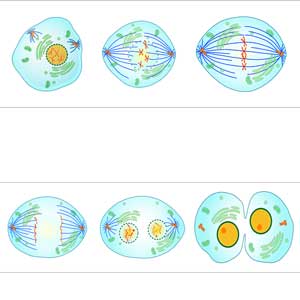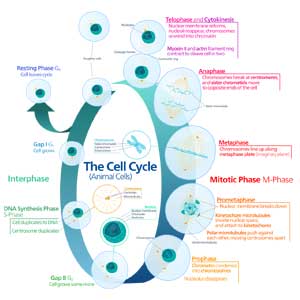Parts of the Cell Cycle
Posted by Nathan D. / in Science Facts

The Cell Cycle - image by By wikimedia.org User:Kelvinsong" class="mw-redirect" title="User:Kelvinsong">Kelvinsong - Own work, CC0, Link
Introduction
- The Cell Cycle is a very interesting topic within the scientific group of Biology. The Cell Cycle is the process in which a cell splits into two identical "daughter" cells. The Cell Cycle has 2 parts, Interphase, and Mitosis. Interphase is split up into three phases.
Interphase
- In G1, is the first part of the entire cell cycle. In G1, the cell begins to duplicate its organelles and grows in size.
- The second phase is know as the "S" phase. In this phase, the DNA is duplicated.
- The third and final part of interphase is called "G2". During this phase, the cell continues duplicating organelles and growing, while also preparing for the second part of the cell cycle, Mitosis.
G1
S-Phase
G2
Mitosis
- Mitosis, also known as the M-phase or the mitotic phase, is the part of the cell cycle in which the cell splits into two separate cells. Mitosis is split into 4 phases, Prophase, Metaphase, Anaphase and Telophase.
- In prophase, the nuclear membrane dissolves and the chromatin condenses into chromosomes.
- Next comes Metaphase where the centrioles in the cell turn into spindle fibers and attach to the chromosomes, they align the chromosomes on the equator of the cell.
- In Anaphase, the spindle fibers begin to tighten and shorten, causing the chromosomes to split in half into chromatids or "daughter chromosomes". These chromatids are pulled to the poles of the cell.
- After Anaphase is finished, the final phases of Mitosis, called Telophase begins. Within Telophase, the spindle fibers disappear and a nuclear membrane forms and the chromatids relax.
Prophase
Metaphase
Anaphase
Telophase

The Mitosis Process - Image Public Domain
Cytokinesis
- After Mitosis has completed, a separate process called Cytokinesis begins. Its job is to completely separate the cytoplasm of the two cells created.
